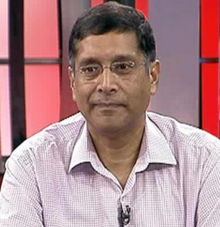Raghuram Rajan, the governor of the Reserve Bank of India (RBI), merely stated the obvious when he said today (August 20, 2015): “It would be a “great help” if realty developers sitting on unsold stock bring down prices…Once the prices stabilise, more people will be keen to buy houses.”
The RBI governor added that property prices need to fall before interest rates on home loans come down, any further. “I think we need the market to clear. With growing unsold stock, we need to see the ways to do it. Some of it might be by making loans easier, but we also don’t want to create a situation where prices stay high at the level which means demand can’t pick up,” he said.
There are multiple points that need to be made here: First is that Rajan was essentially replying to all the real estate wallahs (real estate companies, lobbies and others associated with the sector) who demand interest rate cuts at a drop of a hat. The message from the RBI governor is loud and clear. The home prices are in a bubble zone and he does not want to inflate the bubble further by cutting interest rates. Home prices need to fall.
Also, it is worth mentioning here that even at high interest rates home loans given by banks continue to grow at a very brisk pace. The Reserve Bank of India (RBI) puts out the sectoral deployment of credit data every month. As per these numbers, the total amount of home loans given by banks grew by 15.6% to Rs 6,53,400 crore, over the last one year. In comparison, the overall lending by banks grew by just 7.3%. These numbers were as of June 2015.
How was the situation in June 2014? Home loans had grown by 17.1% to Rs 5,65,000 crore. In comparison the overall lending by banks had grown by 12.8%. What this clearly tells us is that even though the overall lending growth of banks has crashed from 12.8% to 7.3%, home loans continue to grow at a fairly brisk pace.
Further, banks have given out Rs 88,400 crore of home loans in the last one year. This formed around 21% of all the lending carried out by banks. For a period of one year ending June 2014 and June 2013, home loans formed around 12.7% and 12.2% of the total loans given by banks.
What this clearly tells us that banks are giving out a greater amount of home loans as a proportion of their overall loans, than they were in the past. And if this hasn’t led to a fall in inventory of unsold homes, the only reason is that home prices have gone up way beyond what most people afford. Hence, even though the total amount of home loans has gone up, the total number of home loans being given out may have even fallen (This data is not available).
The only way this situation can be corrected is if home prices fall, which is precisely what Rajan said.
The other interesting point that needs to be made here is that central bank governors normally stay away from calling a bubble, a bubble. Alan Greenspan, the Chairman of the Federal Reserve, from 1988 to 2006, was a pioneer in this school of thought. He told the US Congress in June 1999: “Bubbles are generally perceptible only after the fact. To spot a bubble in advance requires a judgment that hundreds of thousands of informed investors have it all wrong. Betting against markets is usually precarious at best.”
So, the Federal Reserve could not spot the dotcom bubble, explained Greenspan. But once it had burst, steps could be taken to ease its fallout, Greenspan felt. As he said in a speech titled Economic Volatility on August 30, 2002: “The notion that a well-timed incremental tightening could have been calibrated to prevent the late 1990s bubble is almost surely an illusion. Instead, we noted in the previously cited mid-1999 congressional testimony the need to focus on policies ‘to mitigate the fallout when it occurs and, hopefully, ease the transition to the next expansion.’”
There is a fundamental problem with this argument. Greenspan was basically saying that the Federal Reserve could not recognize a bubble, but it could figure out when the same bubble had burst.
Raghuram Rajan exposes the flaw in this argument in his book Fault Lines. As he wrote: “This speech seemed to be a post facto rationalization of why Greenspan had not acted more forcefully on his prescient 1996 intuition: he was now saying the Fed should not intervene when it thought asset prices were too high but that it could recognize a bust when it happened and would pick up the pieces.” Greenspan had used the term “irrational exuberance” to describe the dotcom bubble in a speech he had made in December 1996, and then chosen to do nothing about it.
Rajan clearly does not believe in the fact that a central bank cannot identify a bubble. What he said today regarding property prices being high and that they need to fall, before people can start buying homes again, clearly proves that.
Further, the real estate wallahs seem to have come up with a new explanation for why real estate prices cannot fall any further(they have barely fallen to start with). As Shishir Baijal, chairman and managing director of Knight Frank India, a real estate consultancy, told Mint recently: “Theoretically, if prices come down, perhaps the demand can increase. But I’m not sure if developers have any leeway left now for reducing prices. This is because input cost has increased quite a lot over the past few years— be it cost of labour, construction and material, or even the historical cost of land itself, which is very high. It does not look like there is any scope left for a serious correction in prices.”
This, after he had said: “there is a mismatch [between demand and supply] because people are finding it unaffordable (to buy).”And this came, after he had said: “If you look at investor demand, property is not their primary choice anymore. This is due to muted price appreciation, high level of unsold inventory, and the fact that there are other more lucrative financial instruments to choose from. Earlier, there weren’t any options as the equity market was not performing.”
So, investors are not buying because they are not getting high returns from investing in real estate, anymore. The end users are not buying because prices are high. But prices will still not fall, say the real estate wallahs. What sort of an argument is that?
If home prices do not fall, the real estate sector will continue to remain in a mess for a much longer period of time. The market will go through what analysts call a longer time correction (i.e. prices will stagnate for a long period), if prices don’t fall. And this can’t possibly be good for anyone—buyers will continue to stay away, and sellers won’t be able to sell.
This will mean that the real estate companies will continue to hold on to unsold homes that they have accumulated over the years. Given this, Rajan was absolutely right when he said if the market has to function, and buy and sell transactions have to happen, home prices need to fall. The sooner the real estate wallahs understand this, the better it will be for all of us.
(Vivek Kaul is the author of the Easy Money trilogy. He tweets @kaul_vivek)
The article originally appeared on Firstpost.com on August 20, 2015





